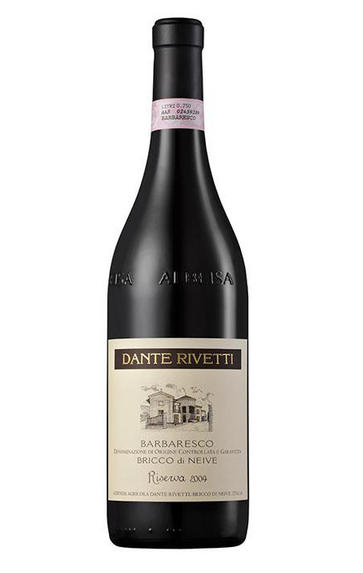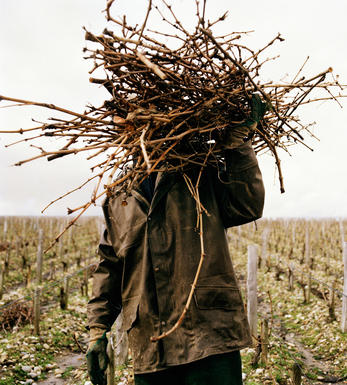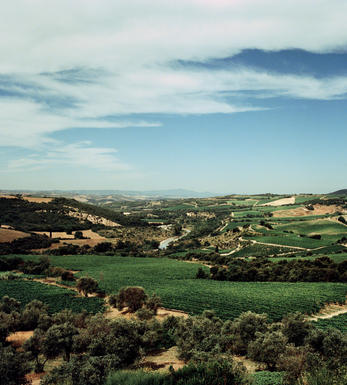
2001 Barbaresco, Bricco di Neive, Riserva, Dante Rivetti, Piedmont, Italy

Critics reviews
Antonio Galloni - 30/10/2008
About this WINE

Az Agri Dante Rivetti
The Dante Rivetti family cantina, located in the small village Bricco di Neive (or Naevia, as the Romans called it), started bottling Barbaresco in 1959.
The 1990s saw the cantina expand from their Bricco di Neive roots, buying up the cascinas of Rivetti, Micca and Costigliole d'Asti. The estate has now grown to 60 hectares, of which 15 hectares is planted to Moscato (supplemented with bought-in fruit), while 18 hectares is devoted to Nebbiolo.
Bric Micca's sandy marine soils breed pretty, fruity, fragrant, sandalwood Barbarescos (planted in 1997), while the older, whiter, clay calcareous soils of Bricco di Neive, along with deeper-rooted older vines, give a more structured, quinine-spice Barbaresco.
Dante and his wife Luciana have since been joined by their children Ivan, Katia and Mara in the winery.

Barbera d'Asti
Barbera is a red wine grape variety native to the Piedmont region of Italy, particularly prominent in the provinces of Asti and Alessandria. It is one of Italy's most widely planted grape varieties, prized for its high yields, adaptability to various soil types, and ability to retain acidity even in warm climates. The Barbera grape typically produces wines with bright acidity, moderate tannins, and deep color, making it a versatile choice for winemakers.
In terms of flavour profile, Barbera wines often showcase a spectrum of red and black fruit flavors, such as cherry, raspberry, plum, and blackberry, along with hints of spice, licorice, and sometimes floral notes. The acidity in Barbera wines provides freshness and structure, balancing the fruitiness and contributing to their food-friendly nature.
Barbera is known for its approachability and versatility, as it can be crafted into a range of styles, from light and fruity wines for immediate enjoyment to more complex and age-worthy expressions. While Barbera wines are commonly enjoyed young for their vibrant fruitiness, some producers also age them in oak barrels to impart additional layers of complexity and texture.
Overall, Barbera is cherished by wine enthusiasts for its reliable quality, food-pairing versatility, and the wide array of expressions it offers, ranging from easy-drinking everyday wines to more profound and cellar-worthy bottlings.

Nebbiolo
Nebbiolo is the grape behind the Barolo and Barbaresco wines and is hardly ever seen outside the confines of Piedmont. It takes its name from "nebbia" which is Italian for fog, a frequent phenomenon in the region.
A notoriously pernickety grape, it requires sheltered south-facing sites and performs best on the well-drained calcareous marls to the north and south of Alba in the DOCG zones of Barbaresco and Barolo.
Langhe Nebbiolo is effectively the ‘second wine’ of Piedmont’s great Barolo & Barbarescos. This DOC is the only way Langhe producers can declassify their Barolo or Barbaresco fruit or wines to make an early-drinking style. Unlike Nebbiolo d’Alba, Langhe Nebbiolo can be cut with 15% other red indigenous varieties, such as Barbera or Dolcetto.
Nebbiolo flowers early and ripens late, so a long hang time, producing high levels of sugar, acidity and tannins; the challenge being to harvest the fruit with these three elements ripe and in balance. The best Barolos and Barbarescos are perfumed with aromas of tar, rose, mint, chocolate, liquorice and truffles. They age brilliantly and the very best need ten years to show at their best.


Buying options
Add to wishlist
Description
This was my stand-out wine from a tasting with Ivan and Katia Rivetti in the hill-locked town of Nieve in Barbaresco. It shows the colours of the white soils of the Bricco di Nieve vineyard, which are more akin to Serralunga in nearby Barolo. The colour is brilliant and light, the nose is full of savoury notes – fine-grained leather and black olive. Dried red berry fruits, garden herbs and sun-dried tobacco fill the palate with vitality and energy. Drink now to 2025.
Davy Zyw, Wine Buyer
wine at a glance
Delivery and quality guarantee